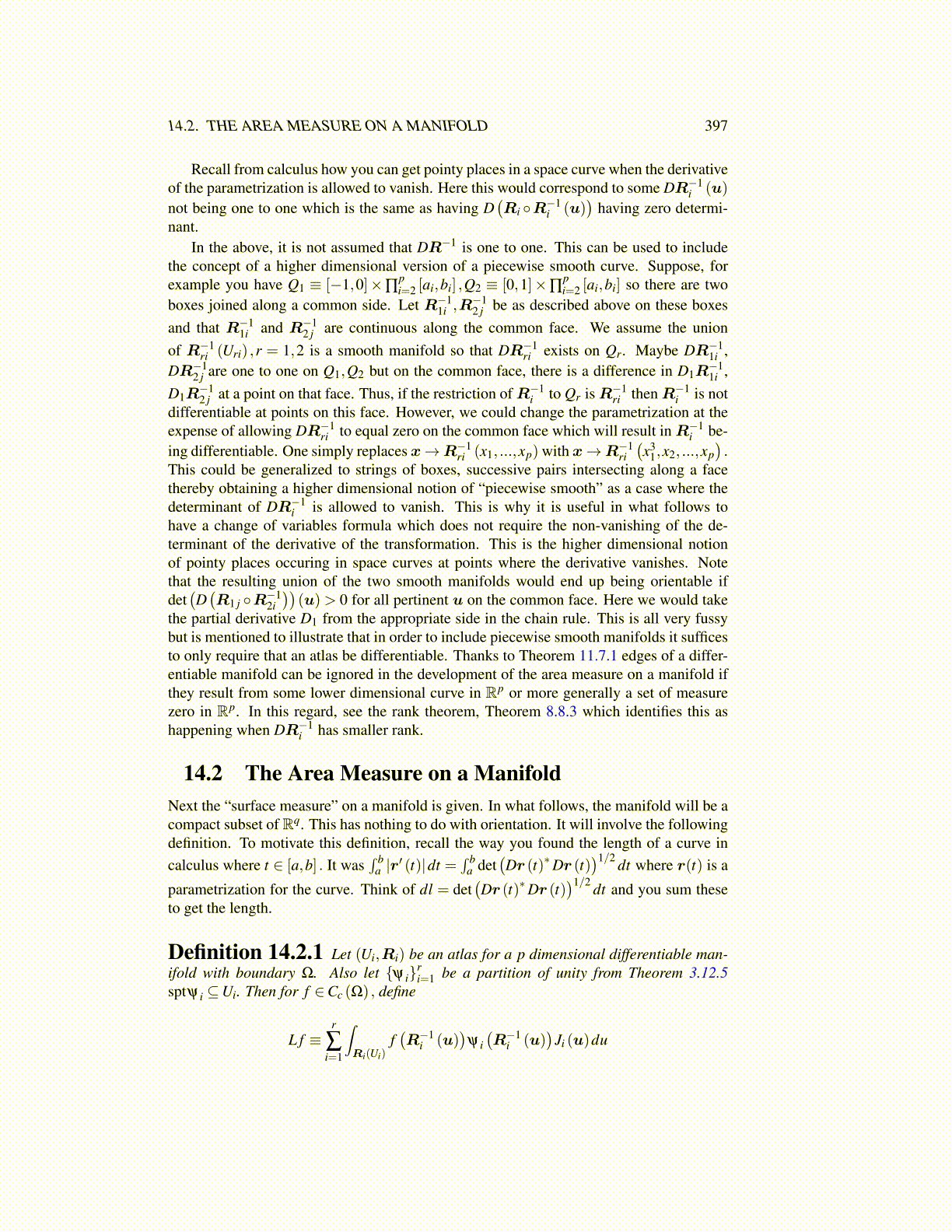
14.2. THE AREA MEASURE ON A MANIFOLD 397
Recall from calculus how you can get pointy places in a space curve when the derivativeof the parametrization is allowed to vanish. Here this would correspond to some DR−1
i (u)
not being one to one which is the same as having D(Ri ◦R−1
i (u))
having zero determi-nant.
In the above, it is not assumed that DR−1 is one to one. This can be used to includethe concept of a higher dimensional version of a piecewise smooth curve. Suppose, forexample you have Q1 ≡ [−1,0]×∏
pi=2 [ai,bi] ,Q2 ≡ [0,1]×∏
pi=2 [ai,bi] so there are two
boxes joined along a common side. Let R−11i ,R
−12 j be as described above on these boxes
and that R−11i and R−1
2 j are continuous along the common face. We assume the unionof R−1
ri (Uri) ,r = 1,2 is a smooth manifold so that DR−1ri exists on Qr. Maybe DR−1
1i ,DR−1
2 j are one to one on Q1,Q2 but on the common face, there is a difference in D1R−11i ,
D1R−12 j at a point on that face. Thus, if the restriction ofR−1
i to Qr isR−1ri thenR−1
i is notdifferentiable at points on this face. However, we could change the parametrization at theexpense of allowing DR−1
ri to equal zero on the common face which will result inR−1i be-
ing differentiable. One simply replaces x→R−1ri (x1, ...,xp) with x→R−1
ri
(x3
1,x2, ...,xp).
This could be generalized to strings of boxes, successive pairs intersecting along a facethereby obtaining a higher dimensional notion of “piecewise smooth” as a case where thedeterminant of DR−1
i is allowed to vanish. This is why it is useful in what follows tohave a change of variables formula which does not require the non-vanishing of the de-terminant of the derivative of the transformation. This is the higher dimensional notionof pointy places occuring in space curves at points where the derivative vanishes. Notethat the resulting union of the two smooth manifolds would end up being orientable ifdet(D(R1 j ◦R−1
2i
))(u)> 0 for all pertinent u on the common face. Here we would take
the partial derivative D1 from the appropriate side in the chain rule. This is all very fussybut is mentioned to illustrate that in order to include piecewise smooth manifolds it sufficesto only require that an atlas be differentiable. Thanks to Theorem 11.7.1 edges of a differ-entiable manifold can be ignored in the development of the area measure on a manifold ifthey result from some lower dimensional curve in Rp or more generally a set of measurezero in Rp. In this regard, see the rank theorem, Theorem 8.8.3 which identifies this ashappening when DR−1
i has smaller rank.
14.2 The Area Measure on a ManifoldNext the “surface measure” on a manifold is given. In what follows, the manifold will be acompact subset of Rq. This has nothing to do with orientation. It will involve the followingdefinition. To motivate this definition, recall the way you found the length of a curve incalculus where t ∈ [a,b] . It was
∫ ba |r′ (t)|dt =
∫ ba det
(Dr (t)∗Dr (t)
)1/2 dt where r(t) is a
parametrization for the curve. Think of dl = det(Dr (t)∗Dr (t)
)1/2 dt and you sum theseto get the length.
Definition 14.2.1 Let (Ui,Ri) be an atlas for a p dimensional differentiable man-ifold with boundary Ω. Also let {ψ i}
ri=1 be a partition of unity from Theorem 3.12.5
sptψ i ⊆Ui. Then for f ∈Cc (Ω) , define
L f ≡r
∑i=1
∫Ri(Ui)
f(R−1
i (u))
ψ i(R−1
i (u))
Ji (u)du